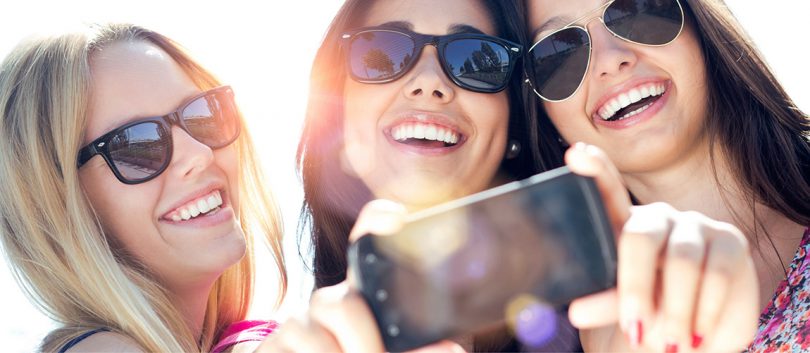A decade ago, it was easy to point to fashion magazines as the source of discontent with how you looked—everyone in the photographs looked so effortlessly glamorous. Today, we still have those magazines, but we also have another source of comparison that’s much more pervasive and intimate: social media.
The always-with-you cell phone camera, the constant posting of photos and videos online and the rise of super-visual apps like Pinterest and Instagram have changed how we perceive ourselves and others.
Meghan Sinton, psychology lecturer at the College of William and Mary, leads a freshman seminar about body image.
“We all have early self-awareness. Around 2 years old we realize things like ‘I have blue eyes.’ ‘I’m tall.’ ‘I have brown hair.’ As we grow older, we begin social comparison and have more abstract discussions. It’s an unfolding process,” Sinton says.
Tethering Identity to Social Media
Sinton says that the ability to see what’s different about ourselves is part of the maturing process, but that there’s a big change in our feedback loop.
“One of the most interesting shifts is the ability to comment and “like” on social media. Magazines didn’t have that interactivity,” Sinton says.
And it’s not just people who know you in real life providing that feedback. The Internet is full of people willing to tell you what they think—and many people who want to be told. Beauty contests or rate me requests on Instagram are now in the thousands—taking judgment and competition global instead of just among yearbook photos. A research brief done by Common Sense Media indicates that 41 percent of teen girls said that they use social media “to make themselves look cooler.”
The pressure to be “camera-ready” all the time is growing for adolescents and young adults. The 2015 report “Children, Teens, Body Image and the Media” confirmed that how young people look and how they feel about how they look is a concern on social media. “Among the teens active on social networks, 35 percent reported having worried about people tagging them in unattractive photos; 27 percent reported feeling stressed out about how they look when they post pictures; and 22 percent reported feeling bad about themselves when nobody comments on or “likes” the photos they post.”
An Inaccurate Portrayal
One of the most deceptive parts of social media images is that they are so touched-up and filtered that they are nearly art instead of realism.
“A lot of images are products. We don’t see the lighting, the makeup artists and the stylist—which most people don’t have. It’s a business to create these images. These are people who don’t exist,” Sinton says. “It’s important to see it for what it is. There’s a disconnect between how we see and internalize [these images] and the intentions of who make [them].”
The effects of seeing these images on our body perceptions are still being researched, but it’s not limited to young women and girls.
“Men are still vulnerable to thoughts about strength and masculinity. They see images of men who are muscular and cut and have six pack abs. It’s just another kind of pressure,” Sinton says.
Betty Eastman, a licensed clinical social worker in Poquoson, Virginia, who specializes in working with adolescents, sees the effects of social media with many of her clients.
“While most adults think of social media as an enhancement to our lives, many adolescents see it as essential. They have computer access sooner and the applications they are using are always changing,” Eastman says.
“There’s a lot of pressure for teenagers to perform at their best and look their best,” Eastman says. “They gauge their popularity on how many followers they have or retweeted or reblogged.”
Many teenagers have unrealistic ideas that can get in the way of real life relationships.
“Do boys think Victoria’s Secret models go to their school? Do they realize how photoshopped some of these images are? There’s lighting and filters and the best scenario portrayed,” she says.
Eastman expressed concern about teenagers relying too much on social media interaction and then having difficulty in face-to-face interactions.
“Anyone can create a seemingly perfect life on Facebook or Instagram, but it’s the real conversations and dealing with feelings that teenagers need to learn how to negotiate appropriately,” she says.
Going From Affirmation to Inspiration
While there are many detriments to substituting online life for real life, social media can also help boost the spread of positive messages. There are campaigns like Dove’s #speakbeautiful campaign to avoid negative body talk online and the Always “Run like a Girl” campaign. And because of social media, young adults and teens can more easily connect and find people like them, because it’s not limited to a small town or your own social circle.
Online, people who are less likely to see positive images of people of their same race or physical characteristics may find them more easily. People dealing with chronic illness may connect with others with the same obstacles and hear advice. Teenagers struggling with gender identity or sexual orientation may find resources and safe places to discuss their feelings. The vastness of the Internet makes it easy to find people who are interested in whatever you are, whether that’s writing fan fiction, learning how to do a fishtail braid or needlepointing rebellious slogans onto pillows.
“There are positive aspects—we can use the power of social media to share images to be celebrated. We talk about behaviors that make you feel beautiful, like community service or spending time with friends. We can use the power of social media to create empowering images. I see people moving more towards recognizing that,” said Sinton.
And hidden within the negative influences on the Internet, there may also be methods for prevention and assistance. For example, alarming Twitter photos of emaciated women tagged #thinspiration have been identified by professionals as promoting eating disorders—but the best prevention method may be to use the same channels to promote positive body images and offer help.
An Ever-Evolving Medium
Research on the effects of “beauty image” and social media are ongoing, and it’s hard to keep up. Each social media channel has its own specific features, including rating systems, photo and video uploads and the currently trendy “evaporating” posts.
Developing a healthy body image is part of healthy development, and many other aspects of an individual’s life depend on being positive. So, in spite of the increasing pressure to be “camera-ready” all the time, we may need to just see it for what it is—a platform to curate beautiful pictures, rather than a reflection of our own shortcomings.
“There are positive aspects—we can use the power of social media to share images to be celebrated.
Infographic (Courtesy Common Sense Media): https://www.commonsensemedia.org/children-teens-body-image-media-infographi


